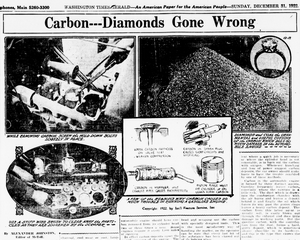|
By accessing/using The Crittenden Automotive Library/CarsAndRacingStuff.com, you signify your agreement with the Terms of Use on our Legal Information page. Our Privacy Policy is also available there. |

Carbon---Diamonds Gone Wrong
|
|---|
|
|
Carbon---Diamonds Gone Wrong
Alexander Johnston
Washington Times-Herald
December 31, 1922
By ALEXANDER JOHNSTON
Editor of MoToR
When the motor car owner is undergoing that inevitable experience of trying to drive and engine that is full of carbon he may find some pleasure in remembering that this black substance, whose very existence spells trouble for him, is a cousin under the bar sinister of the coal that he burns in his furnace and the diamond that adorns his fair lady's hand. Then perhaps he may want to remember also that engine carbon is also closely related to charcoal, coal smut or soot, lamp-black and some other obvious substances.
These latter members of the carbon family are the result of incomplete combustion. If the combustion were complete the carbon would be transformed into carbonic acid gas, which would be dissipated through the exhaust. It is the fact that combustion in the internal combustion engine is seldom complete that we owe the formation of these troublesome deposits. Practically every automobile engine should have carbon removed from its cylinder head two or three times a year. Some engines require it every 1,000 miles of running.
In effect carbon deposits upset the smooth running of the engine. The carbon becomes incandescent. When the inrushing fuel charge comes in contact with this white-hot material it is fired prematurely. The net result is loss of power, knocking and other indications that the engine is "off its food." The only cure is removal of the offending carbon.
There are two principal methods of removing carbon from the cylinder head of the gasoline engine. One of these is by taking off the head and scraping out the carbon with specially designed tools. This is the most satisfactory way of handling the matter, as the operator can be sure that every last bit of the substance has been chased out of its lodging place.
The second method, which is excellent where a quick job is necessary or where the cylinder head is not removable, is to burn out the carbon with oxygen. Whenever knocking and loss of power suggest carbon deposits, the car owner should make haste to have the trouble remedied by one of these methods.
Carbon in the automobile engine is formed by three distinct agents. Gasoline frequently leaves carbon, especially where the mixture is a little rich. The dust which is drawn into the combustion chamber with the air burns and leaves a deposit behind it and finally the oil which forces its way past the piston rings leaves a heavy carbon deposit. The carbon from this latter agent is usually soft, is easily blown out through the exhaust and does little damage to working parts. But the gasoline carbon, with the contribution from the dust, forms a hard, gritty deposit, which is sometimes almost glasslike in its hardness and this is the type that causes the trouble.
(Copyright 1922 by International Feature Service, Inc.)


















